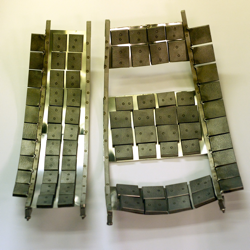To-Ka-Mak
to(roidal'naya) kam(era s) ak(sial'nym magnitnym polem ) ‘toroidal chamber with axial magnetic field.’

Motivation: Whereas magnetic confinement plasma devices generally use stainless steels (especially 316) for its strength and negligible magnetism, these same steels are especially vulnerable to damage from the high fluence of fast (i.e. relatively high-energy) neutrons produced in the deuterium-tritium fusion reaction targeted as the first-generation fusion energy fuel. Although there are many avenues of materials research, the best currently available candidate materials to replace stainless steel, in terms of strength, resistance to neutron damage, and existing large-scale fabrication experience, are a class of "low-activation ferritic steels." However, the fact that these steels are ferritic (i.e. ferromagnetic) means that they are likely to have a generally destabilizing effect on tokamak plasmas.

Completed Research: Prior studies of the "ferritic wall mode" (specific kinds of plasma instability caused by interaction with a ferromagnetic wall) have included an experiment in a linear machine which showed a strong effect, and more conservative studies in Japanese tokamaks which saw a much less pronounced effect. The ferritic wall installed in HBT-EP, intended to bridge this gap, was designed to have a high relative permeability (about 8 times vacuum permeability) and low total soak-through time (due to dividing the wall into roughly 1 sq.in. tiles). Since installation, a series of experiments comparing close-fitting ferritic walls against close-fitting stainless steel with ferritic walls retracted has been conducted, observing:

Ongoing Research: Other topics of interest regarding the ferritic wall include:
| Magnetic | Optical | Feedback | Other |
|---|---|---|---|
| Ferritic Wall | Soft X-Ray | Data Acquisition | Hall Probe |
| Poloidal Sensors | Thomson Scattering | Power Amplifiers | Bias Probe |
| Toroidal Sensors | Fast Camera | CPCI | Mach/Float Probe |
| Rogowski Coils | D-Alpha | Signal Amps | Rotation |
Copyright © 2015 - Columbia University Dept. of Applied Physics and Math - HBT-EP
Template by OS Templates